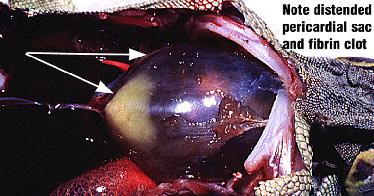| This article has been peer reviewed but is awaiting expert review. If you would like to help with this, please see more information about expert reviewing. |
Cardiovascular disease may be primary or secondary.
Aetiology - it may be infectious, parasitic, congenital or nutritional (e.g. calcification of large vessels)
Clinical signs - Clinical signs of cardiovascular disease are usually non-specific such as anorexia and weight loss. Signs such as swelling in the area of the heart, peripheral oedema and ascites warrant investigation of the cardiovascular system.
Diagnosis
- History
- Physical examination, especially auscultation
- Blood culture
- Radiography
- Ultrasound
- Doppler flow detector
- Electrocardiography though interpretation may be a problem
- Necropsy
Treatment - Includes supportive treatment, antimicrobial if infectious, and correction of husbandry.
Literature Search
Use these links to find recent scientific publications via CAB Abstracts (log in required unless accessing from a subscribing organisation).
Lizard Cardiovascular Disease publications

